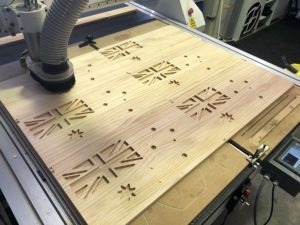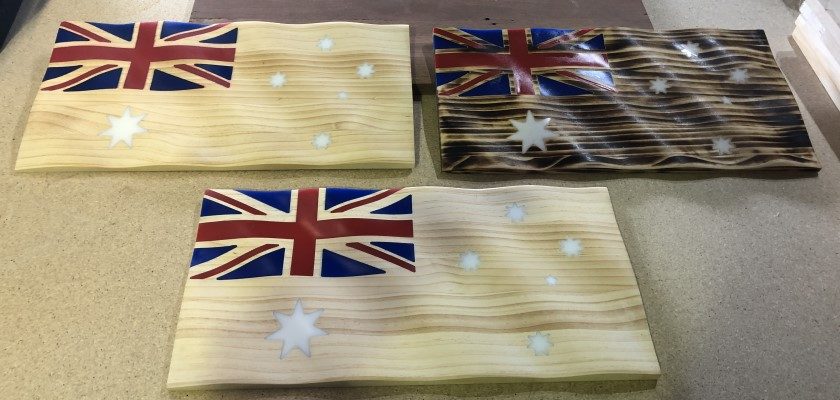As some of you may be aware I am trying to fund the batteries for my Electric Vehicle project by selling a few custom made epoxy infilled wooden flags. The motivation for this project also was to have a go at some 3D carving on my CNC and learn how to pour epoxy successfully. Both of which I have never attempted before. After a bit of trial an error I do believe I found a method and end state which look pretty cool!
 Materials
Materials
Wood – At first I tried to glue and join 2 x flat 19mm pieces of jointed pine together, this turned into an epic failure as the glue did not hold on at the joints and the router eventually chipped away at the carve. Also, weight was an issue here as it made the flag WAY to heavy for the wall. I ended up opting for using a singular piece of 19mm Pine and living with the fact that the waves of flag would not be so deep!
Epoxy – For the epoxy side of things, I did try 3 different types and they all seemed to work. The art epoxy in a 2:1 mix ration was plenty as the pockets I was filling were not too deep.
Epoxy Tip – Make sure you use some kind of sealing agent in the pockets, the porous nature of the Pine meant that you could easily see the ‘bleeding’ of colored epoxy into the wood. I ended up just using clear epoxy to seal the wood after pocketing. This works ok, but you need to make sure you get into all the small crevices thoroughly.
Sanding Pads – Because I carved the waves of the flag into the wood, a flat disc on the orbital sander was not going to work. I was able to pick up some 15mm foam sanding pad attachments that work with any hook and loop orbital sander. This allows the sanding pad to follow the contour of the flags.
Varnish/Sealer – Depending on the finish you want to achieve you will want to experiment with some different wood finishing products. I have about 5 different types. Including a wax.
 CNC Routing the Flags
CNC Routing the Flags
Though time-consuming, this is actually the easiest part. The problem I had, is that you can not just go ahead and carve the 3D flag into the wood and then fill with epoxy. You need to pocket the flag, then fill with epoxy, let it set, and then do the 3D Carve. If you try to do it in reverse the epoxy will flow out of the areas you want to fill as it is no longer level. This process does waste a bit of epoxy, but the results speak for themselves.
I decided on 2 sizes of flags, 250×500 and 1000×500. The process is the same for each size, however, time on the machine for all tool paths is extended on the larger flag.
The Results
No matter the finish I tried to achieve I think all generally turned out pretty good. I ended up with a blue wash flag, a burnt flag, a high gloss flag, and even some flags with presentation plates indented. If you have any other ideas for finishes let me know! I’d be happy to give them a shot.

